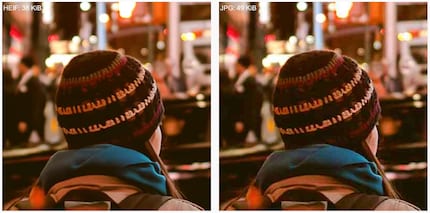
Guide
Tips for better forest photos
by David Lee

The iPhone has been taking photos in HEIF format for a long time now. Windows has recently been able to handle it, as has Canon's latest top-of-the-range camera. Will the very old JPEG finally disappear? It's highly unlikely.
The HEIF file format (sometimes also called HEIC) is becoming increasingly widespread. Apple has been using it for a long time. Since iOS 11, it has been the iPhone's preferred format for taking photos. It has been compatible with Mac since OS 10.13. Android has recognised it since version 9, and Windows 10 has recently been able to manage it too. At CES, camera manufacturer Canon announced the release of its first camera capable of recording shots directly in HEIF.
HEIF stands for "High Efficiency Image File Format". It lives up to its name: HEIF compresses photos much more efficiently than JPEG. Files are significantly smaller for the same quality. The reduction in file size depends on the quality, the dimensions of the photos and the motif, but the files are often half as large. Compression is based on the HEVC video codec, also known as H.265. This is why Apple uses the ".heic" extension.
Unlike JPEG, HEIF or HEVC can compress without loss of quality. In addition, it is possible to record photos with a colour depth greater than 8 bits. The two major drawbacks of JPEG are therefore eliminated.
The advantages of the new format don't stop there. It is a container format that can accommodate different types of content, including audio files. For photography, it's especially interesting to be able to save a group of several images in a single file. This is interesting for burst shooting or HDR bracketing.
Will HEIF replace JPEG? I don't think so. At best, it will find its place alongside JPEG.
There have already been several attempts to replace the JPEG born in 1991. It has never worked. There have never been as many JPEG files produced as there are today.
If the PNG and WebP formats have not entirely replaced JPEG, the reason is relatively obvious. WebP is completely geared towards online display and is therefore unable to show more than 8 bits of colour depth. The compression is certainly more efficient, but the advantages over the well-established JPEG are few.
However, JPEG has surprisingly survived even in the face of formats that were superior to it in almost every respect. In 2000, JPEG2000 was born as the successor to JPEG. It offers lossless compression, extended colour depth, Exif data and many other features that are very useful to graphic designers. However, it was a failure.
Another attempt was made a few years later with JPEG XR. This format was originally called Microsoft HD Photo and was proprietary. Like JPEG2000, JPEG XR is not subject to licence fees. However, both formats are subject to patents that companies can enforce at any time. This may have put off hardware manufacturers and software publishers, especially in the early days.
The persistence of JPEG is primarily explained by the fact that it achieves its purpose, even today. The disadvantages that may seem prohibitive at first glance are not actually so.
There remains the question of colour depth. For a final format, 8 bits is enough. The additional shades available at 10, 12 or 14 bits are for the most part not perceptible to the human eye. They are only used for retouching. With more nuances, I can modify a photo more strongly without negative side effects. For these situations, there is already a file format: the camera's raw data or DNG, the standardised version of it.
Of course, it would be more practical to have one format for everything. If HEIF can replace both JPEG and RAW, then it has a good chance of succeeding. In that case, it would have to reach at least 12 bits and not just 10 as is currently the case, but that would result in significantly larger files.
In fact, the JPEG specifications envisaged that 12 bits would be possible in addition to the 8 bits. However, this was never put into practice.
My interest in IT and writing landed me in tech journalism early on (2000). I want to know how we can use technology without being used. Outside of the office, I’m a keen musician who makes up for lacking talent with excessive enthusiasm.
Practical solutions for everyday problems with technology, household hacks and much more.
Show all
PNG can contain more than 8 bits and also allows compression without loss of quality. While JPEG was optimised for photos, PNG is thought more for graphics such as logos and simple screenshots. It was intended to replace the GIF and has fulfilled this mission, at least in part. For photographers, the biggest problem with PNG is that it cannot record Exif metadata. Exif metadata provides information about how the photo was taken, such as the camera model used, the exposure time or the ISO sensitivity. A format unable to store this information is not an option as an output format on a camera.
The loss of quality associated with compression is very rarely a problem on a day-to-day basis. In a single backup, the shortcomings only become visible at a level of compression never used on cameras. With a good level of quality, defects only appear after successive overwrites of the file. This is not what happens with photo retouching as it is usually practised today. Graphics programs calculate changes from the original files, not from an intermediate result that has already been retouched.